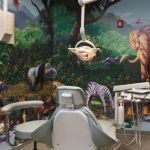How to Fix a Discolored Tooth: Simple Solutions and Professional Treatments
- 1. Understanding Tooth Discoloration
- 2. Common Causes of Tooth Discoloration
- 3. Home Remedies for Fixing a Discolored Tooth
- 4. Professional Treatments for Tooth Discoloration
- 5. Real-Life Example: How I Fixed My Discolored Tooth
- 6. How to Prevent Tooth Discoloration
Dealing with a discolored tooth can be an annoying problem, especially when it affects your confidence and smile. Whether it’s due to food, aging, or other causes, tooth discoloration is more common than most people think. If you've found yourself looking for ways to fix a discolored tooth, you're not alone. In this article, I’ll walk you through some practical methods for addressing discolored teeth, both at home and with the help of a dental professional. From simple lifestyle changes to advanced whitening treatments, let’s explore how you can restore the natural beauty of your teeth.
1. Understanding Tooth Discoloration
Tooth discoloration occurs when the natural color of your teeth changes, often becoming yellow, brown, or even gray. Understanding what causes this discoloration is the first step in determining how to fix a discolored tooth. Teeth naturally become less white over time due to the thinning of enamel, which exposes the yellower dentin layer beneath. However, other factors like food choices, smoking, medications, and poor oral hygiene can contribute to this issue. So, before jumping into treatments, it’s essential to pinpoint the cause.
1.1 Types of Tooth Discoloration
There are two main types of tooth discoloration: extrinsic and intrinsic. Extrinsic discoloration occurs on the outer layer of the tooth, often due to food, beverages, or tobacco. Intrinsic discoloration affects the inner layers of the tooth and is usually caused by aging, genetics, or certain medications. Both types can be addressed, but the methods may differ based on the cause of the discoloration.
2. Common Causes of Tooth Discoloration
Knowing the reasons behind tooth discoloration can help you prevent it from happening again in the future. Some of the most common causes of discolored teeth include:
2.1 Diet and Beverages
One of the main culprits for tooth discoloration is the food and drinks we consume. Coffee, tea, red wine, and certain fruits can stain your teeth over time. I’ve personally noticed that after enjoying my morning cup of coffee, my teeth tend to look more yellowed. Dark-colored sauces like soy sauce and balsamic vinegar can also contribute to staining. If you’re regularly consuming these types of foods, you might be more prone to tooth discoloration.
2.2 Smoking and Tobacco Use
Smoking is another major cause of tooth discoloration. Nicotine and tar from cigarettes can quickly stain the enamel of your teeth, leading to yellow or even brown discoloration. I had a friend who struggled with tooth discoloration for years, and after quitting smoking, his teeth gradually returned to a more natural shade.
2.3 Medications
Certain medications can cause teeth to become discolored. For instance, some antibiotics like tetracycline can stain teeth if taken during childhood, while antihistamines and blood pressure medications can darken teeth as well. I once had a course of antibiotics that left a slight gray tint on my teeth, and it took a while to restore their natural color.
3. Home Remedies for Fixing a Discolored Tooth
If you’re looking for a quick and affordable way to fix a discolored tooth, there are several home remedies you can try. While these may not offer immediate results like professional treatments, they can help improve the appearance of your teeth over time. Here are some options I’ve personally tried and found helpful:
3.1 Whitening Toothpaste
Whitening toothpaste is one of the most accessible methods to reduce tooth discoloration. These toothpastes contain mild abrasives that help remove surface stains. I started using a whitening toothpaste and noticed my teeth gradually became brighter after a few weeks. However, if your discoloration is more severe, this may not be enough to fully restore your smile.
3.2 Baking Soda and Hydrogen Peroxide Paste
Baking soda is another popular remedy for tooth discoloration. Combined with hydrogen peroxide, it creates a paste that can help remove stains and whiten your teeth. I’ve tried this method a few times, and it worked well for removing surface stains. Just make sure to use it sparingly, as excessive use can damage enamel.
3.3 Oil Pulling
Oil pulling, which involves swishing coconut or sesame oil around in your mouth, has gained popularity as a natural way to whiten teeth. Although the science behind it is still debated, many people (including myself) have found it effective at improving the overall appearance of their teeth. I typically oil pull for 10-15 minutes every morning, and over time, I’ve noticed my teeth look a little brighter.
4. Professional Treatments for Tooth Discoloration
If home remedies aren’t giving you the results you want, it might be time to consult a dentist for professional treatments. These treatments tend to be more effective and faster than at-home methods. Here are some common professional solutions for fixing discolored teeth:
4.1 Teeth Whitening
Teeth whitening is the most common professional treatment for discoloration. Dentists use stronger bleaching agents than over-the-counter products, and these treatments are often more effective at removing both extrinsic and intrinsic stains. I went to my dentist for a professional whitening session and was amazed at how much brighter my smile looked afterward. It took about an hour, and the results lasted for several months.
4.2 Veneers
If your teeth are severely discolored and whitening doesn’t give you the desired results, veneers may be an option. Veneers are thin shells of porcelain or composite resin that cover the front of your teeth, masking discoloration. This option is more expensive than whitening, but it can completely transform the appearance of your smile. I’ve seen several friends get veneers, and they’ve been thrilled with the outcome.
4.3 Bonding
Dental bonding involves applying a tooth-colored resin to the surface of the tooth to correct discoloration. This is a quicker, less invasive option compared to veneers. I had a small discoloration on my front tooth that my dentist was able to fix with bonding, and the results were both natural and long-lasting.
5. Real-Life Example: How I Fixed My Discolored Tooth
A few months ago, I noticed one of my front teeth had become slightly yellow. It wasn’t a dramatic discoloration, but it was noticeable enough to make me self-conscious when smiling. I tried using whitening toothpaste for a couple of weeks, but the results were minimal. After consulting my dentist, I decided to try a professional teeth whitening treatment. The process was fast and painless, and within an hour, my teeth were noticeably whiter. I was thrilled with the results and felt much more confident when talking to people. For anyone dealing with mild to moderate discoloration, I highly recommend this option.
6. How to Prevent Tooth Discoloration
Once you’ve fixed a discolored tooth, it’s important to take steps to prevent it from happening again. Here are some tips that have helped me maintain a bright smile:
6.1 Regular Brushing and Flossing
Keeping your teeth clean is essential for preventing stains. Brushing at least twice a day and flossing once can help remove food particles and plaque that can contribute to discoloration. I’ve made it a habit to brush after meals, especially when I’ve had foods or drinks that could stain my teeth.
6.2 Limiting Stain-Causing Foods
As much as I love coffee and wine, I try to limit my consumption of these stain-causing foods. When I do indulge, I make sure to rinse my mouth with water afterward to minimize the staining effects. This simple step has made a noticeable difference in keeping my teeth bright.
6.3 Regular Dental Visits
Finally, seeing your dentist regularly is key to maintaining a healthy smile. Professional cleanings can help remove stains that brushing alone can’t, and your dentist can provide personalized advice on how to prevent discoloration. I visit my dentist every six months for cleanings, and it has helped keep my teeth in excellent condition.
In conclusion, if you're dealing with a discolored tooth, there are several ways to address the issue. From simple home remedies to professional treatments, there’s a solution for everyone. If you're looking to improve the appearance of your smile, I encourage you to explore your options, whether it's through at-home methods or professional dental care. Remember, a bright smile can do wonders for your confidence and overall appearance!







 Deem Thomas E DDS5.0 (4 review)
Deem Thomas E DDS5.0 (4 review) Sung Lee Orthodontics5.0 (108 review)
Sung Lee Orthodontics5.0 (108 review) Articolo Orthodontics5.0 (4 review)
Articolo Orthodontics5.0 (4 review) Elmwood Park Cosmetic Dentistry5.0 (1 review)
Elmwood Park Cosmetic Dentistry5.0 (1 review) Children's Dental Health of Plymouth Meeting4.0 (352 review)
Children's Dental Health of Plymouth Meeting4.0 (352 review) Lakeshore Family Dentistry: Jason P. Ross, Ellen D. Jacobson5.0 (3 review)
Lakeshore Family Dentistry: Jason P. Ross, Ellen D. Jacobson5.0 (3 review) The Importance of Oral Health Education During Pregnancy for a Healthy Pregnancy
The Importance of Oral Health Education During Pregnancy for a Healthy Pregnancy Best Tips for Brushing Your Teeth Properly for Healthy Gums: Essential Techniques for Oral Health
Best Tips for Brushing Your Teeth Properly for Healthy Gums: Essential Techniques for Oral Health Why Skipping Dental Checkups Can Lead to Bigger Oral Health Problems
Why Skipping Dental Checkups Can Lead to Bigger Oral Health Problems Advantages of Porcelain Dental Restorations
Advantages of Porcelain Dental Restorations How Can Diabetes Cause Tooth and Gum Problems? Preventing and Managing Oral Health Issues
How Can Diabetes Cause Tooth and Gum Problems? Preventing and Managing Oral Health Issues Healthy Habits for Promoting Good Oral Health and Hygiene: Tips for a Healthy Smile
Healthy Habits for Promoting Good Oral Health and Hygiene: Tips for a Healthy Smile